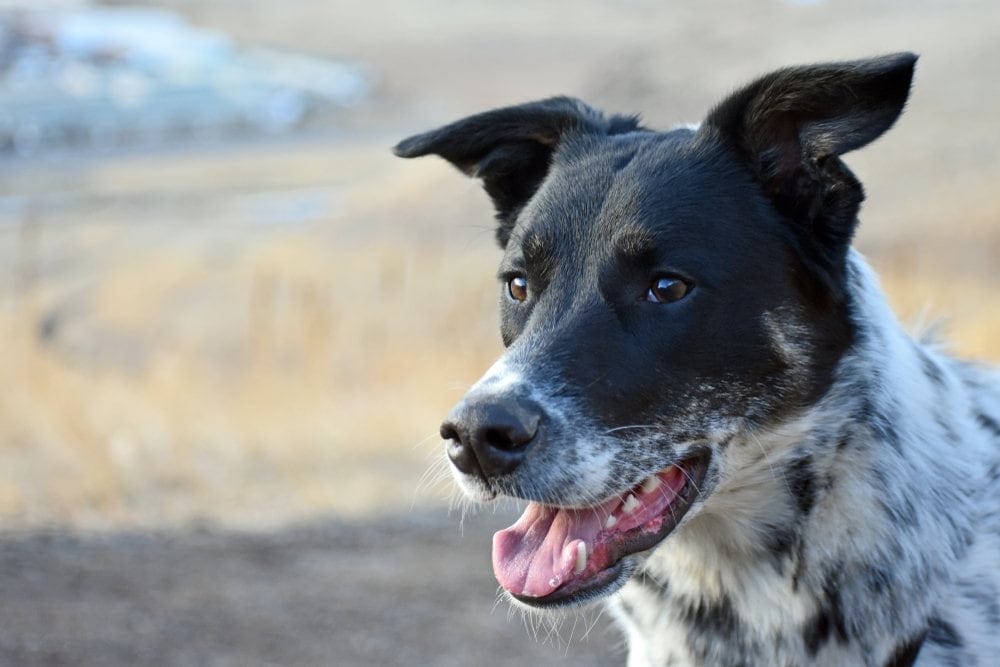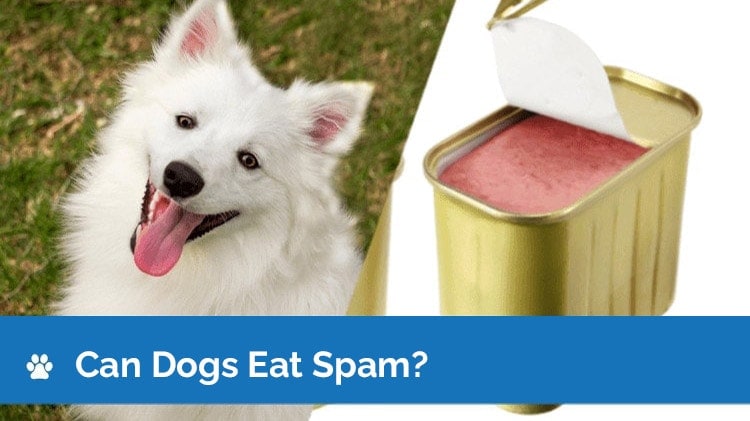Can Dogs Eat Raw Meat? Vet Reviewed Risks & Benefits

Updated on
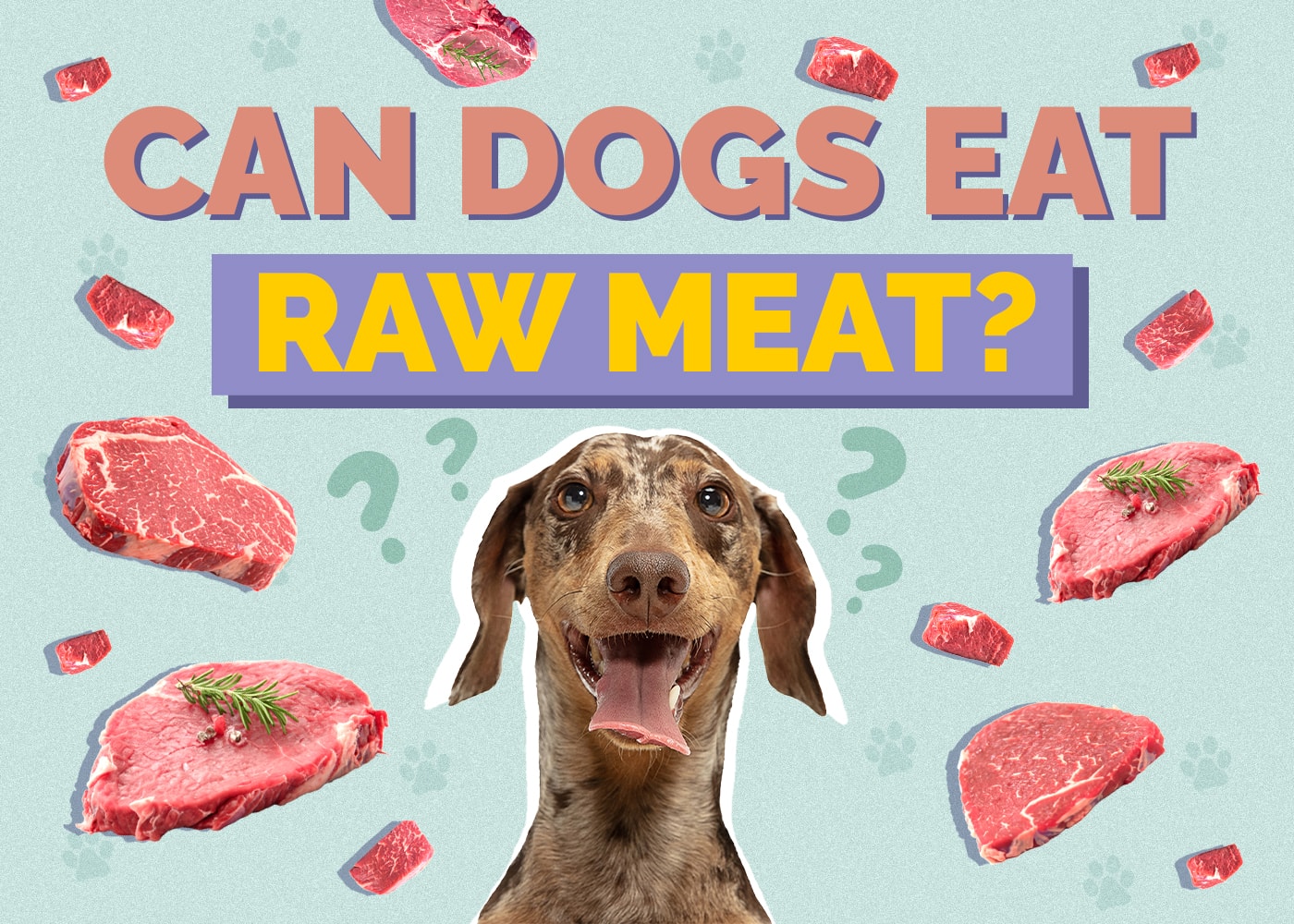
There is no doubt that dogs love their meat, and many owners wonder if it is safe to offer their pup a raw diet. Feeding your pup raw meat can be a controversial issue, as many owners are all for it, and some are against it. While some sources suggest that feeding raw meat to your dog is a healthy and balanced diet, others have raised concerns about the potential risks, such as increased bacteria and parasites.
With so much conflicting information out there, it’s critical to understand the facts before deciding whether to let your pup enjoy raw meat. This article will delve into the nutritional benefits and potential risks that come with feeding your dog raw meat, so you can make an informed decision about what’s best for your pup.
 Can Dogs Eat Raw Meat?
Can Dogs Eat Raw Meat?
The answer to the question of whether dogs can eat raw meat is actually yes, but it should be given with caution and not as the exclusive food source. You should also know that the American Veterinary Medical Association cautions against giving dogs raw meat only. This is because raw meat may not meet all of their nutritional needs.
By nature, being that dogs are related to wolves, you may think that they are carnivores, with meat making up the majority of their diet. You will have no problem finding many pet owners who have fed their dogs raw meat diets since they’ve owned them, and you may also find some who’s dogs have developed food-borne illnesses as a result.
However, in reality, the majority of dogs are fed an omnivorous diet, meaning that they don’t just need meat sources to maintain their health. They can also gain many nutrients and lots of fiber from plant-based foods. Many commercial dog foods are made up of both meat and plant ingredients.
The thing is that many pet owners in the US are switching their dogs to a raw diet, also known as a BARF diet. As raw meat dog foods become more popular and readily available, it’s likely that this trend will increase for the near future. It is important to make sure that your dog is receiving a well-balanced diet that contains all the vitamins and minerals that it needs to stay healthy.
So, while a raw diet can be a great option in some cases, it’s always important to first speak to your dog’s veterinarian who can go over your dog’s history (and current state of health) and offer guidance on whether or not a raw diet will be good for your pup specifically.
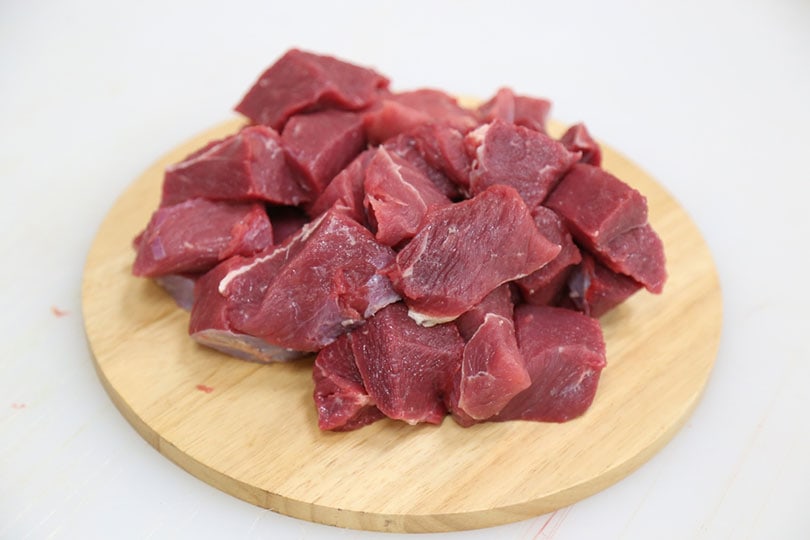
What Is the BARF Diet?
A raw diet for dogs, also known as a BARF (Biologically Appropriate Raw Food) diet, consists of raw, uncooked meat and vegetables. This type of diet is based on the idea that dogs should eat the same type of food as their ancestors did before the domestication of dogs.
Raw diets for dogs can consist of raw meat, organs, bones, fruits, and vegetables. Some owners may also choose to supplement their dog’s raw diet with other food sources, such as eggs, dairy products, and grains. The main goal of a raw diet is to provide your pup with a balanced and nutritious diet that is free of processed ingredients. Proponents of raw diets argue that it’s the healthiest choice for dogs, as it is closer to their natural, evolutionary diet.
The Potential Pros of Feeding Raw Meat to Dogs
It’s Balanced
Feeding your pup raw meat can be a great way to provide them with a balanced diet, if it has been formulated correctly. A raw meat-based diet will meet dogs’ daily protein requirements since these are typically very high in protein. (Note: Dogs need 1 gram of protein per pound of body weight. So, a 15-lb dog would need 15 grams of protein each day). (Note: the AAFCO (Association of American Feed Control Officials) recommends that the daily requirements of protein for dog diets should be at least 22% DM (dry matter) for growth and 18% DM for maintenance). Raw meat-based diets are usually lower in carbs, which help to keep your pup’s energy levels up. But as long as the diet is formulated appropriately, your dog will get all they need with this diet. Raw meat diets can also be beneficial for dogs with grain allergies as they are usually free of grains and fillers.
It May Improve Its Coat
In addition, some owners report that their pup’s coat is softer and shinier after switching them to a raw diet. This is likely due to the high quality of the protein and the natural fat found in raw meat (particularly omega fatty acids), which helps to keep their skin and coat healthy.
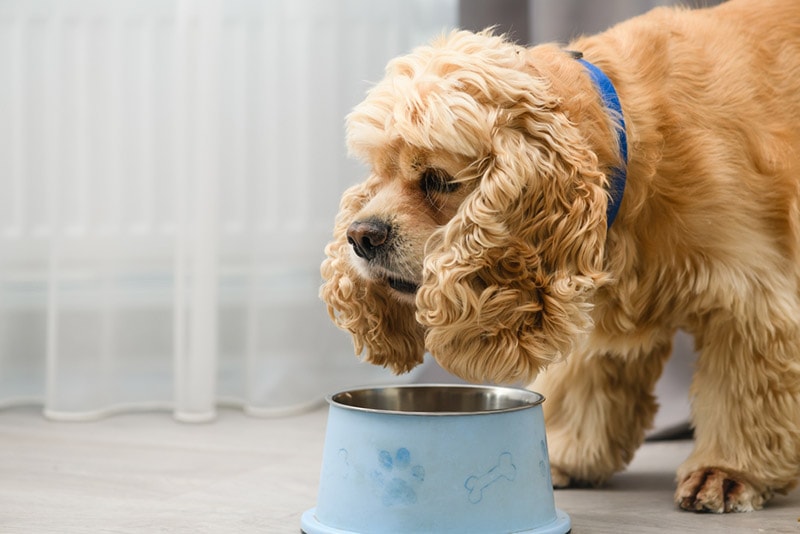
 The Risks Associated with Feeding Raw Meat to Dogs
The Risks Associated with Feeding Raw Meat to Dogs
While there are many potential benefits to feeding your pup raw meat, there are also some risks to consider.
Lack of Nutritional Value
When it comes to the nutritional value of raw meat, you should note that not all raw diet plans are created equal. While some raw diets can be nutritionally balanced, others may be a bit lacking when it comes to certain nutrients like omega-3 fatty acids, vitamins, and minerals.
It also helps to understand that not all raw meats are the same. For example, beef is typically higher in fat than chicken, and pork is higher in fat than beef. Organ meats such as liver and heart should be eaten in moderation and make up a small proportion of your dog’s raw meat-based diet. They may contain higher amounts of trace minerals like zinc, iron, and copper. So be sure to do your research and choose a variety of raw meats to ensure that your pup is getting all the nutrients they need. You may need to supplement your dog’s diet if you’re switching to 70%-100% raw food. Always follow the advice of your vet or vet nutritionist to find a complete and balanced diet for your dog no matter what you’re feeding them.
Potential for Illness
One of the main concerns with feeding raw meat to dogs is the potential for bacteria and parasites. Raw meat can contain bacteria such as salmonella, listeria and E. coli, as well as parasites including protozoa, tapeworms, and roundworms. These bacteria and parasites are usually killed when the meat is cooked, but when it is uncooked, your dog can become ill if the raw meat contains any of them.
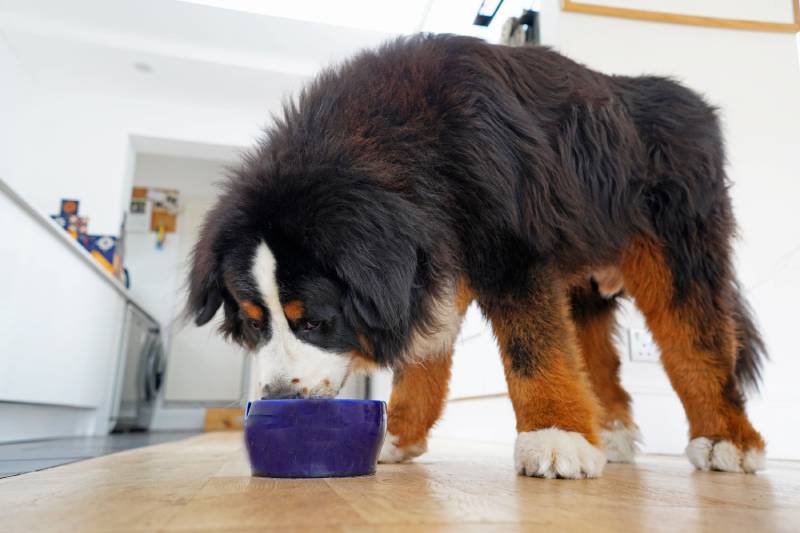
More on Bacteria & Parasites
One of the main concerns with feeding your pup raw meat is the potential for bacteria and parasites. So, while it’s true that raw meat can contain bacteria and parasites, there are some steps you can take to reduce the risk
First, be sure to only purchase raw meat from reputable sources. Next, always thoroughly wash your hands, utensils, and work surfaces after handling any raw meat that you give your dog. Finally, store and handle raw meat quickly and properly to avoid cross contamination. It’s best to freeze the meat as soon as you purchase it to keep it as fresh as possible – try to use it within 2 days or freeze it.
You don’t want to leave raw meat in your refrigerator for weeks at a time, as it’ll grow more bacteria by the day, making it more dangerous to eat in its raw state (and even in a cooked state if left too long).
And then there are certain meats that you simply want to avoid feeding to your dog raw more than others, which are pork, salmon, and shellfish. These types of meat are more prone to containing parasites and bacteria, which can be harmful to your pup.
 Tips for Transitioning a Dog to a Raw Diet
Tips for Transitioning a Dog to a Raw Diet
Switching your dog’s regular kibble or wet food over to a raw food diet is a pretty big deal. So, it’s crucial to do a lot of research and planning beforehand and follow your vet’s recommendations. Let’s look at a few ways that you can ensure that you are introducing your dog to a raw diet the right way.
Start Slowly
If you decide to transition your pup to a raw diet, be sure to do so slowly. For example, begin by replacing one of your pup’s meals with a small amount of raw food – like maybe 5%-15% of raw food. Gradually increase the amount of raw food over the next few weeks, while decreasing the amount of their old food. This will help to ensure that your pup’s digestive system can handle the switch to a raw diet.
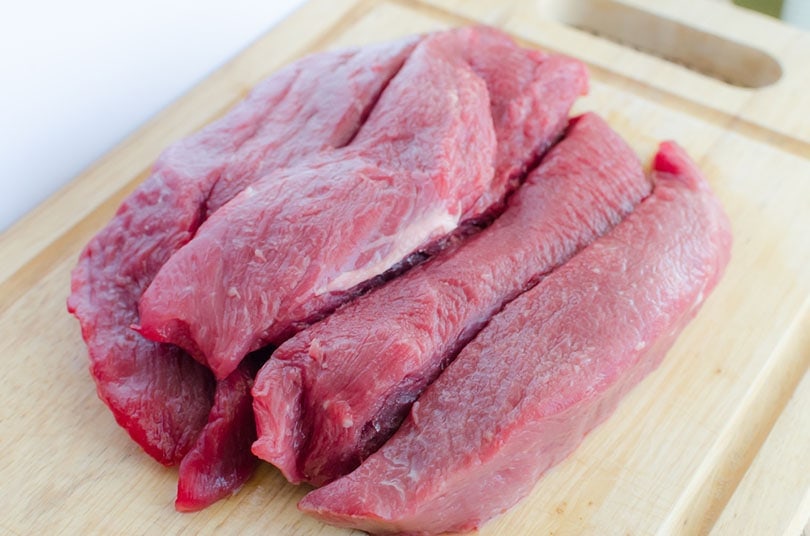
Monitor Your Dog’s Eating Habits
Also, be sure to monitor your dog during the transition process. Look for signs of vomiting, indifference, diarrhea, or other digestive issues. If your pup is having any of these issues, you’ll want to contact your vet right away. If your dog seems a bit hesitant to eat the raw food, be sure to mix it in with the other foods well.
You may even want to consider mixing a bit of beef or chicken broth into the food to make it more desirable or cook it minimally. By design, processed dog food (wet and dry) has a distinctive smell that draws dogs to eat it and fresh raw food doesn’t really carry a strong odor that will entice the dog from several feet away.
Only Feed Fresh, & Thaw Meat First
If you decide to feed your pup raw meat, always do so responsibly. This means staying away from old or stale meats. The safest way to feed raw meat is to feed it frozen or freshly thawed, as the cold temperature helps to kill any potential bacteria. Also, make sure that all bones are either cooked or ground before feeding, as raw bones (especially fish bones) can splinter and cause choking or internal injuries.

 Alternatives to Raw Meat for Dogs
Alternatives to Raw Meat for Dogs
If you aren’t comfortable feeding your pup raw meat, there are many alternatives to consider. One popular option is to feed your pup a commercially prepared balanced diet, such as dry kibble or wet food. These types of food are typically fortified with vitamins and minerals and are formulated to meet your pup’s protein and general nutritional requirements. Be sure to read your dog’s food label and understand the information. The food should be complete, balanced, and tailored to your dog’s life stage.
Another option is to sign up for a subscription of fresh dog food that will ship your dog’s cooked meals to your door. You can also prepare your pup’s meals at home, but you will have to get a nutritionist to formulate your dog’s diet for you. This can involve mixing together cooked meats (like chicken, beef, and fish), grains, and vegetables, and adding vitamin and mineral supplements as necessary. This can help you feed your dog a whole food diet while ensuring that you’re minimizing any chance of bacteria or parasite consumption. And after cooking the meat, you can simply store any leftovers in the freezer for 2 to 3 months.
Wrapping Things Up
So yes, dogs can eat a raw diet, but most vets caution against it, and especially against only feeding your dog raw meat. Feeding your pup a complete and balanced raw meat-based diet might be a great way to provide them with a balanced and nutritious diet. But before doing so, you should have your vet give you the okay and then introduce the raw food to your dog slowly over a period of time.

 Can Dogs Eat Raw Meat?
Can Dogs Eat Raw Meat?
